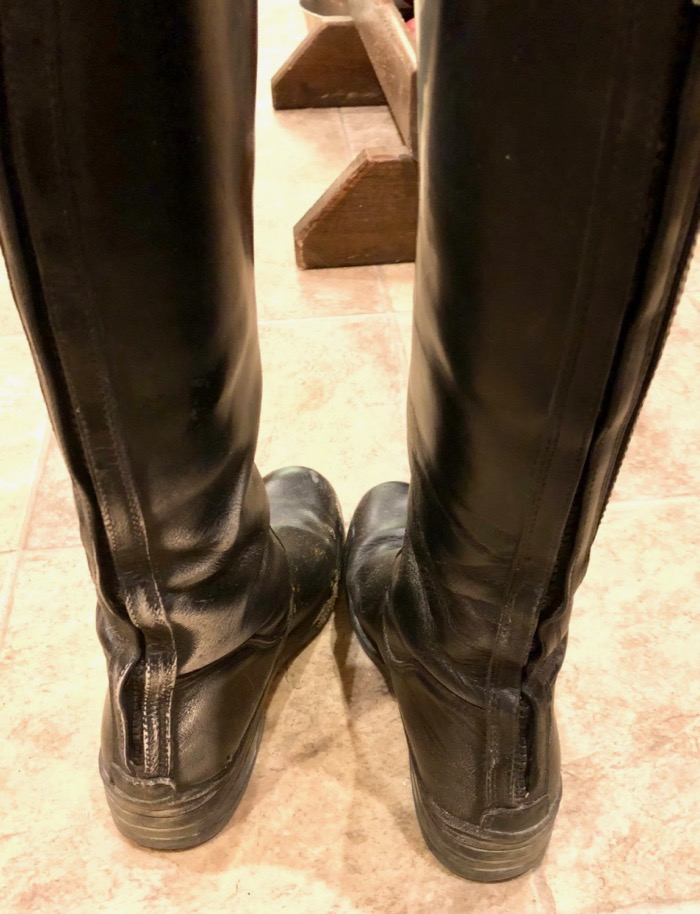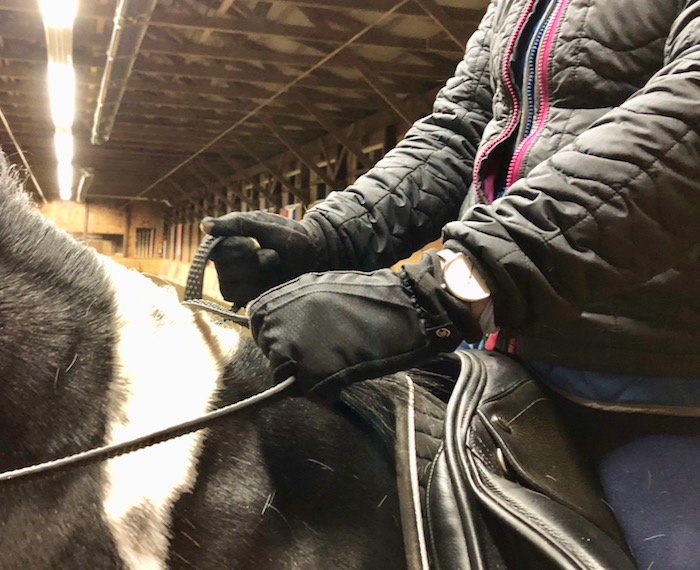Humans find symmetry beautiful. (Google this. Fascinating research!) We also equate symmetry with athleticism. Oh, to be an ambidextrous baseball batter! But most of us are either left or right-handed. Beyond that, wear and tear alters our posture. Perhaps a shoulder droops a little, or we’re stronger on one leg than another. Maybe a broken ankle never set straight.
Beyond beauty (which is a valid goal and integral to dressage), symmetry is something that riders should strive for. Riding is body-to-body communication, rider to horse, horse to rider. Because at its best and most nuanced it’s made up of slight shifts of weight – a press of a calf, a tightening of a finger, a dip in the poll – being crooked can throw off the conversation.
I wish that I were symmetrical, but I am not. My boots show the evidence. In winter, my horse’s dander sticks to my boots where I rub against him the most. Obviously, my left ankle is tighter against his side.

Try as I might, my left sitting bone is a tad further forward in the saddle than my right.

Everything is tied together. My left hand is also lower.

This matters. Tonka feels the pull on his left side, which can cause him to brace with his jaw. It’s more difficult for him to track up on the left side and to step energetically, when my less elastic left hip and leg block his movement.
It goes both ways. Tonka has mild arthritis in his left hock, so he steps shorter on that side. His sacroiliac issues have him moving more stilted when cantering to the right. Some of my imbalance comes from compensating for him! It’s hard to find a plumb seat on a crooked horse. But it’s possible, and it’s something that I am aware of and work towards every time I get in the saddle.
Of all of my position faults, it’s my hands that cause the most misunderstandings with my horse.
The conversation goes better when my hands are in this position.

Held like this, my thumbs control the length of the reins. My ring fingers can soften, or vibrate, or be still, depending on what we need to say to each other. When my hands are like this, I have a bend in my elbows, and that allows me to give with elasticity to the movement of Tonka’s head. When my left hand is parallel to the right, my left shoulder squares up and my weight no longer tips heavier on that one side. Seemingly small changes – getting my knuckles perpendicular to the withers, and my hands held at an equal height – can do all of this.
Getting stronger in my core, more open in my shoulders, and more flexible in my joints, has enabled me to hold my hands in that improved position. But, they don’t stay there. They keep falling back to the old default. It’s been so frustrating! But, I’ve finally figured out a way to retrain myself.
I frequently count strides out loud when riding. For example, I’ll decide to trot twelve, walk six, trot eight. Counting out loud evens out my breathing and releases tension (you can’t hold your breath!) and it makes me aware of the cadence. Tonka hears it and moves to it, too. We get rhythmic and we flow. Also, it makes me conscious of my transitions, and they become more exact when I plan out exactly when they’ll happen. While doing this counting, I realized that when I corrected my hand position, it would stay correct for four strides, but by the fifth, I’d lost it. So, I used counting to fix my hands.
I started from a point of success, that fourth stride, before my position fell apart. I said out loud, one, two three, four. At first my wrists started to rotate at that fourth stride, and I’d remind myself to get my thumbs up. Once I was able to go around the ring without having the position deteriorate every four strides, I counted for five. Then six. It was very rewarding to me when I’d count and realize that I didn’t have to do anything, that my hands had stayed in their proper place. It was also rewarding that this exercise seemed to free up Tonka’s way of going. I was lighter, and that made him lighter.
Since focusing on my hands, and counting my way to a better position, something else has happened. My left boot is no longer dirtier than the right. Sometimes if you fix one piece, it all works together. (I’ve written about that here.)
Do you have a position issue that frustrates you? Being harangued about heels down doesn’t work does it? Try this: when not moving, sit on your horse exactly the way you’d like to ride. What does it feel like? Once you are sitting in your optimum position, walk on. Count strides. How many until your body goes back to it’s default? If it’s four, then practice riding correctly for three strides. Celebrate being in sync with your horse for that many. When that feels easy, count four. Soon enough, you’ll have a new default.
Let me know if this helps!


YES! We are working on the very same thing! Even on the same side (left). We have discovered that when I put my left leg on her for a bend, I brace with my left arm, which causes her to tighten and resist on her left side…which causes all sorts of mysterious tight spots for her massage therapist (my wee beastie girl is 19 and we are working on keeping her fit right to the last day…she gets massages, I don’t). Anyway, I haven’t thought of counting (I sing while I ride to keep breathing). We will count strides and see how that works for keeping our cues at the front of my brain. Thanks!
Thank you for this comment! I sing if Tonka gets tense on the trail, but I find that counting has a lot more benefits in the ring. Let me know how the counting goes!